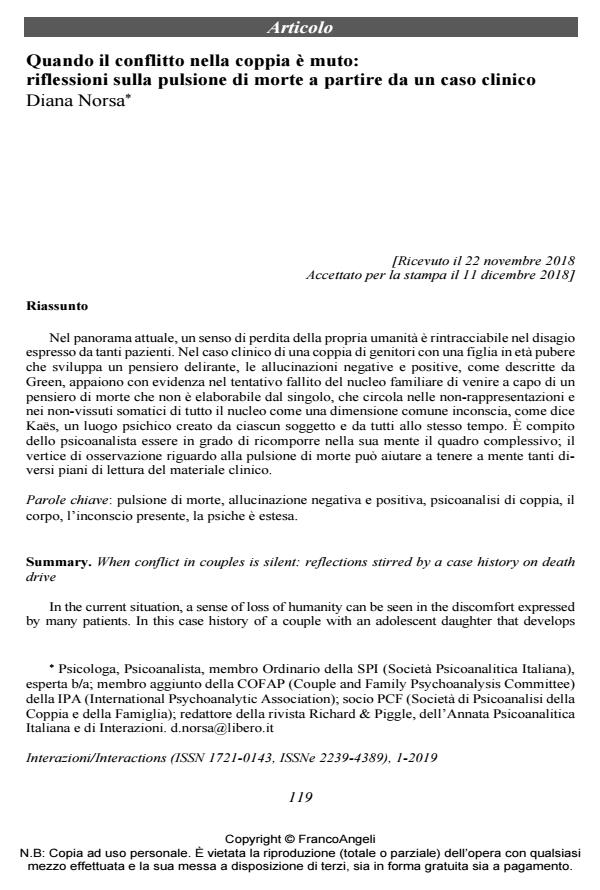When conflict in couples is silent: reflections stirred by a case history on death drive
Journal title INTERAZIONI
Author/s Diana Norsa
Publishing Year 2019 Issue 2019/1 Language Italian
Pages 15 P. 119-133 File size 171 KB
DOI 10.3280/INT2019-001009
DOI is like a bar code for intellectual property: to have more infomation
click here
Below, you can see the article first page
If you want to buy this article in PDF format, you can do it, following the instructions to buy download credits

FrancoAngeli is member of Publishers International Linking Association, Inc (PILA), a not-for-profit association which run the CrossRef service enabling links to and from online scholarly content.
In the current situation, a sense of loss of humanity can be seen in the discomfort expressed by many patients. In this case history of a couple with an adolescent daughter that develops delusional thoughts, the negative and positive hallucinations, as described by Green, emerge clearly in the failed effort of the family at understanding death thoughts that cannot be elaborated by each individual but float around the members in their not-representations and somatic non-experiences like in a shared unconscious dimension, as Kaës calls it, a psychic location created by each member separately and by the whole family at the same time. The task of the analyst is to be able to reassemble the overall picture in her mind; the vertex of the death drive can be useful to put together the many different levels of understanding of the clinical material.
Keywords: Death drive, negative and positive hallucinations, couple psychoanalysis, body, present unconscious, extended psyche.
- Ameisen J.C. (1999). Al cuore della vita. Milano: Feltrinelli, 2001.
- Auster P. (2005). Follie di Brooklyn. Torino: Einaudi.
- AA.VV. (1975). Il libro Tibetano dei Morti. Roma: Ubaldini, 1977.
- Calasso R. (2017). L’innominabile attuale. Milano: Adelphi.
- Freud S. (1920). Al di là del principio di piacere. OSF, vol. 9. Torino: Bollati Borin-ghieri.
- Freud S. (1938). Risultati, idee, problemi. OSF, vol. 11. Torino: Bollati Boringhieri.
- Green A. (1993). L’allucinazione negativa. In Green A., Il Lavoro del negativo. Roma: Borla, 1996.
- Green A. (2003). Negativo e Negazione in psicoanalisi. In Baldassaro A. (a cura di), La passione del Negativo. Milano: FrancoAngeli, 2018.
- Kaës R. (2007). Un Singolare plurale. Roma: Borla.
- Klein M. (1929). Infantile Anxiety Situations Reflected in a Work of Art and Creative Impulse. The International Journal of Psycho-Analysis, 10: 436-452.
- Milner M. (1987). La follia rimossa delle persone sane. Roma: Borla.
- Nancy J.L. (2000). Corpus. Paris: Edition Métaillé.
- Norsa D. (2017a). Dora and Carlo. In Scharff D.E., Palacios E. (Eds.), Family and Couple Psychoanalysis. London: Karnac.
- Norsa D. (2017b). Sulla soglia. Rivista di Psicoanalisi, 63, 3: 609-626.
- Preta L. (2015). La brutalità delle cose. Milano: Mimesis.
- Rosenfeld H. (1987). Comunicazione e Interpretazione. Torino: Bollati Borinhieri, 1989.
- Sandler J., Sandler A.M. (1998). Gli Oggetti Interni. Milano: FrancoAngeli.
- Searles H. (1959). Il tentativo di far impazzire l’altro. In Searles H., Scritti sulla schizofrenia. Torino: Boringhieri.
- Searles H. (1960). L’ambiente non umano. Torino: Einaudi.
- Valdrè R. (2016). La morte dentro la vita. Torino: Rosemberg & Sellier.
- Winnicott D. (1967). La delinquenza come segno di speranza. In Winnicott D.W., Dal Luogo delle Origini. Milano: Raffaello Cortina.
Diana Norsa, Quando il conflitto nella coppia è muto: riflessioni sulla pulsione di morte a partire da un caso clinico in "INTERAZIONI" 1/2019, pp 119-133, DOI: 10.3280/INT2019-001009